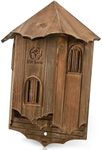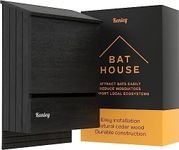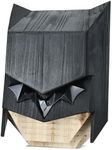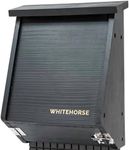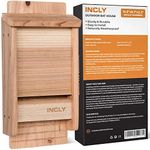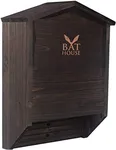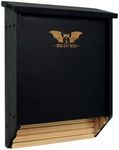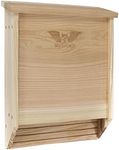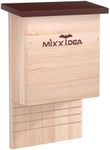Buying Guide for the Best Bat Boxes
Choosing the right bat box is important if you want to support local bat populations and encourage them to roost in your area. Bat boxes provide a safe, sheltered space for bats to rest and raise their young, especially as natural roosting sites like old trees and buildings become less available. When picking a bat box, it's important to consider the needs of the bats in your region, the climate, and where you plan to install the box. Understanding the key features will help you select a box that is both attractive to bats and durable over time.MaterialThe material of a bat box affects its durability, insulation, and safety for bats. Most bat boxes are made from wood, woodcrete (a mix of wood and concrete), or sometimes recycled plastic. Wooden boxes are common and provide good insulation, but they need to be made from untreated, rot-resistant wood to avoid harming bats. Woodcrete is more durable and offers better temperature regulation, but it can be heavier and more expensive. Recycled plastic is weather-resistant but may not insulate as well. Choose a material that suits your climate and maintenance preferences—woodcrete for longevity and insulation, wood for a natural look and lighter weight, and plastic for low maintenance.
Size and CapacityThe size of a bat box determines how many bats it can accommodate and how suitable it is for different bat species. Small boxes may house a handful of bats, while larger boxes can support colonies of dozens. If you want to support a larger bat population or have multiple species in your area, opt for a bigger box. For smaller gardens or if you’re just starting, a compact box is sufficient. Think about the space you have and the likely bat activity in your area when choosing the size.
Chamber DesignBat boxes can have single or multiple chambers. Single-chamber boxes are simpler and easier to install, suitable for small numbers of bats or for beginners. Multi-chamber boxes provide more space and temperature options, making them more attractive to larger colonies and a wider range of species. If you want to maximize your chances of attracting bats, especially in areas with variable temperatures, a multi-chamber design is a good choice.
Entrance SlotThe entrance slot is the opening through which bats enter the box. Its size and placement are important for bat safety and to keep out predators. A narrow, bottom-placed slot is best, as it allows bats to climb in easily while deterring birds and other animals. Look for boxes with an entrance slot about 1.5 to 2.5 cm wide—wide enough for bats, but not for larger animals. This feature is especially important if you have predators like cats or birds in your area.
Surface TextureThe inside surfaces of a bat box should be rough or grooved to help bats grip and climb. Smooth surfaces can make it hard for bats to roost or move around. Check that the box has roughened wood, mesh, or grooves inside. This is especially important for young bats learning to climb, so if you want to support breeding colonies, prioritize boxes with textured interiors.
Weatherproofing and VentilationA good bat box should protect its inhabitants from rain, wind, and extreme temperatures, while also allowing for airflow to prevent overheating. Look for boxes with sloped roofs, overhangs, and tight seams to keep water out. Ventilation slots or holes near the bottom or sides help regulate temperature and humidity. If you live in a hot climate, extra ventilation is important; in cooler areas, prioritize insulation and weatherproofing.
Mounting OptionsHow and where you can mount the bat box affects its success. Some boxes are designed for mounting on trees, while others are best on buildings or poles. Consider the mounting hardware included and whether the box is easy to install at the recommended height (usually 3–6 meters above ground). If you have limited mounting options, choose a box that is versatile and comes with clear instructions.
